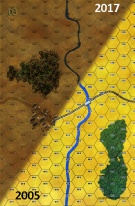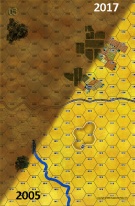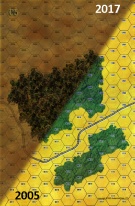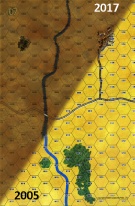|
Tank Battle at Ostrov: Day One Eastern Front #26 |
||
|---|---|---|
| (Attacker) Germany | vs | Soviet Union (Attacker) |
| Formations Involved | ||
|---|---|---|
| Germany |  |
1st Panzer Division |
| Soviet Union |  |
3rd Tank Division |

|
| Overall Rating, 8 votes |
|---|
|
3.75
|
| Scenario Rank: 243 of 957 |
| Parent Game | Eastern Front |
|---|---|
| Historicity | Historical |
| Date | 1941-07-04 |
| Start Time | 06:00 |
| Turn Count | 50 |
| Visibility | Day |
| Counters | 97 |
| Net Morale | 0 |
| Net Initiative | 1 |
| Maps | 6: 1, 3, 4, 5, 6, 7 |
| Layout Dimensions | 86 x 84 cm 34 x 33 in |
| Play Bounty | 109 |
| AAR Bounty | 142 |
| Total Plays | 8 |
| Total AARs | 5 |
| Battle Types |
|---|
| Bridge Control |
| Inflict Enemy Casualties |
| Meeting Engagement |
| Conditions |
|---|
| Off-board Artillery |
| Randomly-drawn Aircraft |
| Scenario Requirements & Playability | |
|---|---|
| Eastern Front | Base Game |
| Introduction |
|---|
|
With German panzer spearheads pushing ever closer to Leningrad, birthplace of the Revolution, the Red Army committed more and more of its reserve mechanized corps to stop them. First Mechanized Corps had trained in the Pskov maneuver area south of the great city since the previous autumn and had elderly equipment but a better than average cadre. Col. K. Yu. Andreev had only taken command of 3rd Tank Division on 17 June, less than three weeks before he was ordered to stop the German XLI Panzer Corps. The tankers of his 6th Tank Regiment passed through the lines of 111th Rifle Division and fell on the Germans as they crossed the intact rail and highway bridges at Ostrov. |
| Conclusion |
|---|
|
Andreevhad prepared as best he could, picking up seven factory-fresh KV tanks on the way to the battlefield and giving them his best crews. But he'd already lost his rifle regiment and several tank companies, frittered away to support other units in the previous two weeks of war. The Soviet tankers drove right through the Germans, shooting up their soft vehicles and pressing close to both bridges. But lack of infantry support prevented a signal Soviet victory, and the Red Army men pulled back to try again the next day. The German commander, Lt. Gen. Friedrich Kirchner, radioed for help and his unit's sister division began a rapid march to join the 1st Panzer in their bridgehead. |
| AFV Rules Pertaining to this Scenario's Order of Battle |
|---|
|
| 5 Errata Items | |
|---|---|
| Scen 26 |
This scenario uses the old 1d6 system for river crossings (the 3rd Edition rules use 2d6). You can tell because the number for AFVs is "1". You can't roll a 1 or less on 2d6. Whenever the river crossing numbers are 6/2/1 or 5/2/1, you are rolling just one d6 (and trying to roll equal to or less than those numbers, by type, Foot/Motorized/AFV). (Shad
on 2010 Apr 29)
|
| Scen 26 |
This scenario has river crossing numbers and a major river, but no engineers! (see Rule 5.7: major rivers can only be crossed at bridges or with engineer assistance). Let all units attempt to cross as if an engineer were there (boats, fords, pre-planned wading attempts, etc.) using the crossing numbers as if an engineer were present. (Shad
on 2010 Apr 29)
|

|
The reduced direct fire value of the Heer HMG became 5-5 starting with Fall of France. (plloyd1010
on 2015 Jul 31)
|

|
The morale and combat modifiers of German Sergeant #1614 should be "0", not "8". (Shad
on 2010 Dec 15)
|

|
All SPW 251s have an armor value of 0. (Shad
on 2010 Dec 15)
|
| Push to the Bridges! | ||||||||||||
|---|---|---|---|---|---|---|---|---|---|---|---|---|
Setup: the Germans spread themselves evenly on the North side of the river by Turn 3, while the Soviet tanks and 4 SMG's, moved to the town on Board 4, and waited for the aircraft to soften the German defenses, and then move in. Play: For the first ten turns, consisted of soviet airplanes and artillery to bombard the germans near the east bridge, hoping to make a dash attack in the latter half of the scenario. After the bombardment had stopped, the germans had only taken one step loss, and only a couple of units where disrupted. By this time, the Soviet player decided to engage the Germans. The heaviest tanks moved down the road, while the Bt-7's flanked the heavies. The German tanks began to fire at the Soviets, but after two turns, only one step of Soviet tanks were destroyed. The heavies slammed into the roadblock, while the Germans fired from each side, signaling the forces to the forces west to move in and counter the soviet attack. However, the countermove stalled when a soviet BT rolled a 12 against a PzIIIF, destroying the lead element. The next turn, the assault on the roadblock turned to the favor of the Soviets, when they rolled a 6 on the 30 col, eliminating the remaining steps in the assault, clearing the way to the bridges. The heavies then continued towards the bridges, while the other tanks and SMG's moved to secured the road, defending against further German attacks. In the last turns of the game, the Germans launched attacks on the remaining Soviet forces around the bridge on Board 7. Unfortunately, Soviet OF cut down what was left of the German forces. In the end, the soviets were able to recapture the bridge, and defend from the Germans. Soviet Vicotry -- 5/5 |
||||||||||||
| 0 Comments |
| Vers Ostrov |
|---|
|
Vers Ostrov. Les allemands doivent prendre deux ponts. Quelques tanks mais en face, les russes ont une grosse force de blindés (des éléments de la troisième division) mais par contre presque pas d'infanteries. Au bout de douze tours, les allemands se sont enterrés devant les deux ponts, mais les chars russes ont éliminé tous les blindés allemands, au prix de fortes pertes. Les allemands ont déjà gagné au vu de ces pertes, les russes vont essayer de prendre un pont pour arracher un match nul, mais je ne suis pas sûr que des blindés quasi seuls puissent déloger une infanterie solidement accrochée. Les russes vont donc essayer de prendre un pont pour arracher le match nul, puisqu'ils avaient déjà perdu aux points. Eh bien, ça n'a pas marché. Les allemands enterrés sont restés impassibles devant le bombardement à distance des chars lourds KV1, et ceux-ci n'ont pas tenté l'assaut frontal vu le faible soutien d'infanterie. |
| 0 Comments |
| Who needs infantry? I've got tanks, lots of them! Well I did, once... |
|---|
|
This is a huge scenario (mapwise) and gives the Soviets the chance to have significant armor superiority. The key for the Soviets is to understand that with virtually no infantry they are very vulnerable to assault. The Soviets had terrible gunnery luck in this one which led to an earlier demise than normal but the lack of infantry is so dramatic that they simply didn't have the right force for the task. Interestingly the expanse of the field is such that it tends to suck German forces away from the key points as defined by the Soviet thrust. |
| 0 Comments |
| tank battle part is interesting |
|---|
|
Germans dug-in infantry up to three lines deep around both bridges, backing up the eastern bridge with their AT batteries. Soviets sent a majority of the BT-7s and T-26s at the eastern bridge defenders to soften them up and lure in the panzers. KV-1s forward-deployed into the town on board 7, backed by a couple of BT-7s to provide flanking shots. The Germans declined to take on the KV-1s and instead flanked the trees on board 4 and targeted BT-7s and T-28s in the board 4 town. A few turns of exchanges reduced armor on both sides. The Soviets were gaining the upper hand, but at too much of a cost in tanks. Also, their attempts to soften up the eastern bridge defenders yielded only modest results - two infantry step losses. Note though the Soviet OBA and aircraft destroyed the German mortars and AT guns. After about halfway through I called it for the Germans. They needed to knock out only two more Soviet steps, and the Soviets had far too much work left to make a meaningful dent in the eastern bridge defenders. In conclusion, the tank battle was really interesting, but the severe lack of Soviet infantry rendered the infantry engagements inconsequential. |
| 0 Comments |
| Two bridges too far | ||||||||||||
|---|---|---|---|---|---|---|---|---|---|---|---|---|
If this one was merely a tank battle then in time the Soviets may of prevailed but there is much more required than just winning an armored engagement here. The Soviets had to take control of at least one of the two bridges on the southern portion of the battlefield but in order to do that had to get through a mass of German foot units that chose to dig-in around each bridge area. And before they could attempt that they had to get through a sizeable amount of panzers first. The Soviets had a few platoons of SMG units and just two leaders to support a very large armored contigent and keeping those foot units intact to support an attack on either bridge area proved to be futile. The Germans recieved 3x16 increments of OBA each turn and that artillery support combined with the on-board mortar units quickly took a heavy toll on the Soviet foot units and also managed to disrupt or demoralize a few armored units as well. Rather than wait for an attack the Germans go on the offensive with panzers supported by some infantry platoons. The KV-1s become the prime targets for infantry assaults as they are the only Soviet armored units that the panzers cannot really handle on their own. Early on German OBA was able to disrupt one of the slow moving KV-1 platoons and wipe out it's supporting foot unit and it soon became isolated and chased down by German infantry. Soviet airstrikes were highly ineffective at slowing German foot units down even when they received two aircraft every four turns; in fact, by the time the battle was over all those annoying aircraft had managed to do was eliminate one demoralized German Lieutenant and cause a few failed morale checks but even then much too late to make a difference. As for the actual tank v.s. tank portion of the battle the Soviets did have the upper hand to start. The one good ordered KV-1 platoon easily picked off a few PzIIIGs that had dug-in on the north-south road while the BT-7s that had taken up defensive postions in one of the towns managed to also eliminate a few panzers. However, in time, with Soviet numbers diminishing and after all of their leaders and SMG units were eliminated more German INF units left their dug-in positions near the bridges to successfully assist the panzers at the crucial moments. Soon it became clear for the Soviets that taking either one of the bridges would be impossible. A few platoons of T-26s made it to the outer defenses of the eastern bridge but were checked there before they could press further. Even one of the German 37mm AT guns deployed on the southern bank of the river was able to get one lucky shot in with reduced firepower and extreme range; rolling the needed "12" to knock out one of the T-26 steps. Then with further OBA and infantry assaults those remaining T-26s attempting to threaten the eastern bridge were easily dispatched. By 10:45/turn 20, there wasn't much left of the Soviets and soon it came down to the Germans chasing around one demoralized platoon of T-26s and a reduced and disrupted KV-1 platoon; all other Soviet units had been destroyed. The SSR #4 states that any units fleeing the board are eliminated and that is exactly what became of the last of the T-26s; chased off the eastern map, fleeing from where they entered and the remaining KV-1 was successfully assaulted and eliminated by German INF. So this battle ends at 12:15/turn 26. All the Soviets have left are air units but they cannot take control of either bridge let alone even take out an AT gun. I don't know what the best strategy for the Soviets to win or even get a draw in this one; the only way is to take control of either bridge and they never even really came close. I suppose they could of entered the more cautiously and further north but eventually both the panzers and German INF would catch up with them anyway. With a potential 50 turns the Soviets can take their time but most of their tanks, apart from the BT-7s, only have a move rate of 5 so they can easily be tracked down. Even then I don't know what the Soviets can do to protect their foot units or armor against German OBA. Triple stacking Soviet units was out of the question as German OBA on the 42 column was efficient enough. I suppose that someone could get a lot luckier with Soviet air-support as to what planes get drawn and actually hitting their targets. It was frustrating enough when single, lower rated aircraft like the Po-2 biplanes were drawn and even more so when more powerful aircraft like the IL-2s missed their targets. It will very interesting to see how further plays of this one turn out through future AARS, especially with potential Soviet wins. In my solo play the Germans brought the battle to the Soviets rather than sit back, yawn and wait for them to attack and that seemed to pay off. At one point I thought all of the panzers would get wiped out and all but one step of the PzIIIGs actually did. But the remaining PzIIIFs held on and even the scorned PzIIs survived this one and managed to take out one step of BT-7s at point-blank range. Not a bad scenario, it gets an average "3" but was really amazed this one was over after just 26 turns out of 50 allowed. |
||||||||||||
| 0 Comments |

 EFDx025
EFDx025 




























